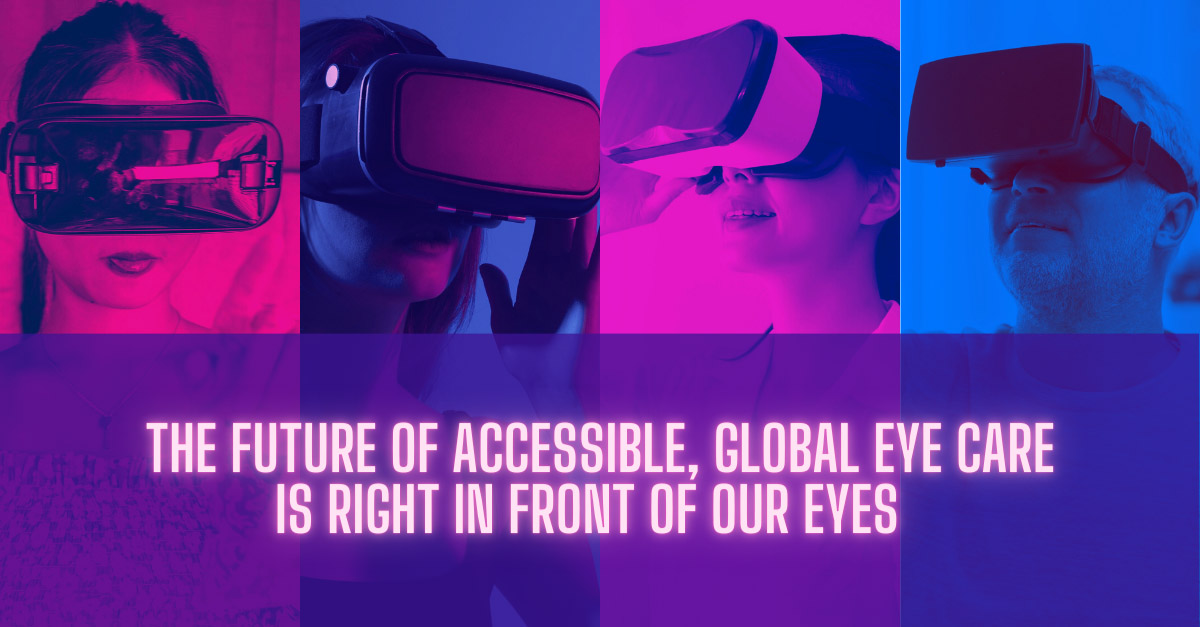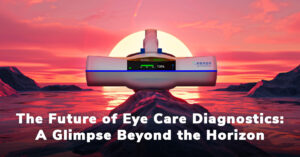The healthcare field has been revolutionized in recent years with the advent of new technologies. One such technology is software-based ophthalmic examinations administered through a wearable headset. As a result, this type of system is becoming increasingly popular in the field of eye care.
These wearable examination devices can potentially improve patient access to care and care quality while increasing the number of patients eye care professionals can manage in their practice. This article will discuss the benefits of an HMD-based (head-mounted display) virtual ophthalmic exam system like the Xenon Ophthalmics™ XO Exam™ ophthalmic diagnostic exam system.
What is a Wearable Eye Exam System?
A wearable ophthalmic diagnostic system is a type of head-mounted display (HMD) that allows users to experience a simulated but highly precise eye examination environment using high-resolution screens, advanced optics, and eye motion sensors to track eye movements.
Users can interact with this environment through hand controllers or other input devices. These systems have found applications in fields such as gaming, entertainment, and education. However, they have also been used in healthcare—particularly in eye care.
Benefits of a Wearable Examination System in Eye Care
1 Increased Efficiency
A wearable ophthalmic examination system can increase the efficiency of eye care professionals by reducing the time it takes to perform fundamental aberrometry and visual field exams. Traditionally, eye exams require a series of manual tests, which can take up to an hour, excluding patient wait times.
However, with a wearable system, eye exams can be completed in a matter of minutes. This increased efficiency allows eyecare professionals to see more patients in a day, improving their practice’s financial viability.
2 Enhanced Diagnostic Accuracy
A headset system can also improve the accuracy of eye exams. For example, the medical-grade XO Exam system from Xenon Ophthalmics can provide detailed and accurate measurements of the eye’s anatomy, which can help detect subtle changes in the patient’s vision that might indicate the onset of a disease.
The wearable system environment can simulate various lighting conditions such as those experienced by a driver on the road at night. Such a simulation helps identify the effects of glare on a patient’s line of sight in addition to the effects of other environmental factors on the eyes.
Additionally, the system can record and analyze eye movement which can help diagnose conditions like amblyopia, and can be challenging to detect with traditional methods.
3 Improved Patient Experience
New ophthalmic diagnostic devices, such as wearable headset exam systems, can improve the patient experience during an eye exam. Even in the most efficient vision care practices, waiting and exam times, from check-in to check-out, can run from 1 ½ to 2 hours. This lack of time efficiency can lead to patient frustration, rescheduling, or outright cancellations. Starting a medical examination requiring patient engagement, cooperation, and feedback when the patient is frustrated can negatively impact the outcomes.
Traditional eye exams can also be physically uncomfortable and intimidating for some patients. For example, sitting still and providing feedback to the practitioner for an extended period may not be a reasonable request for the very young, the elderly, or those with conditions that impact their ability to remain motionless, compliant, and offer effective feedback.
Moreover, an eye examination will often require pupil dilation via eye drops that further discomforts the patient and effectively extends the time dedicated to the exam until the drops wear off.
However, next-generation wearable diagnostic devices can provide patients with a much more relaxed and engaging experience. These devices are comfortably fitted to the patient and can administer multiple, highly precise aberrometry and visual field examinations in a fraction of the time required by a traditional exam lane and without pupil dilation.
This more efficient exam methodology can reduce patient anxiety and make them more comfortable. Additionally, the system can provide real-time feedback and guidance, which can help the patient understand the exam process and feel more in control throughout their visit.
4 Increased Access to Care
A wearable ophthalmic diagnostic HMD system can also increase access to eye care. In many parts of the world, eye care professionals are in short supply, and patients may need to travel long distances to receive care.
An aging population, intensive use of device screens, and lifestyle changes have dramatically increased the global demand for vision correction. According to a World Health Organization (WHO) report, “globally, at least 2.2 billion people have a near or distance vision impairment. In at least 1 billion – or almost half – of these cases, vision impairment could have been prevented or has yet to be addressed.”
A wearable eye exam system can provide a way for patients to receive eye care remotely, reducing the need for travel and increasing access to care. Additionally, the system can be used in non-traditional settings, such as schools or community centers, to provide eye care services to underserved populations.
5 Lower Costs for the Practitioner
A wearable headset examination system can also reduce the cost of eye care. Traditional eye exam lanes require highly specialized physical equipment, which can be expensive to purchase and require a significant commitment to office space. Beyond the initial capital outlay to lease or buy the equipment, there are ongoing training, maintenance, upkeep, and calibration costs incurred by the equipment.
Additionally, these exams can be time-consuming, which can increase the cost of the exam. However, an ophthalmic HMD system requires only a headset and a computer, which can be significantly less expensive than traditional equipment. Additionally, the system’s increased efficiency can reduce the overall cost of care.
Conclusions for Eyecare Professionals
In conclusion, an ophthalmic diagnostic head-mounted display (HMD) system can provide numerous benefits in vision care. These next-generation diagnostic devices can provide more precise, comfortable, and convenient eye exams for eye care patients. These systems can also help increase exam lane efficiency for eye care professionals, enhance diagnostic accuracy, improve the patient experience, increase access to care, and lower costs compared to conventional exam lane equipment. As the technology of ophthalmic HMD systems continues to advance, their applications in eye care will likely only continue to grow.
But not all wearable ophthalmic diagnostic exam systems are created equally. Many existing systems use off-the-shelf headset technology suited for gaming. Their hardware and specifications are not vetted for performing medical grade exams. As you consider adding wearable headset exam technology to your practice, be sure the device meets clinical diagnostics standards such as Goldmann and other key essential medical-grade standards.
Next-Generation Medical Grade Ophthalmic Diagnostics
Xenon Ophthalmics™ is on a mission to transform how eye care is delivered around the globe. Our XO Exam™ system of interchangeable, wearable ophthalmic diagnostic units offers next-generation aberrometry (XO Exam™ ABT) and visual field (XO Exam™ VFT) examinations to increase access to eye care.
Our XO Exam™ system is the only medical-grade technology to meet the increasing global demand for eyecare and the eyecare professionals’ ability to meet that demand with the highest level of patient care and practice growth potential.
XO Exam™ ABT (Aberrometry)
XO Exam™ ABT offers three critical subjective aberrometry tests (Digital Phoropter, Wavefront Aberrometry, and Retinoscopy) with greater accuracy, speed, and patient comfort than conventional optical exam equipment.
XO Exam™ VFT (Visual Field)
XO Exam™ VFT offers seven different visual field diagnostic tests and critical pupillary measurements with greater accuracy, speed, and patient comfort than conventional optical exam equipment.



